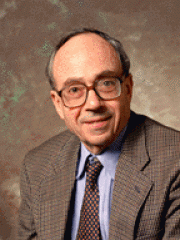Name Stanley Mandelstam | Role Physicist Doctoral advisor Richard Dalitz | |
 | ||
Institutions Thesis Some Contributions To The Theory And Application Of The Bethe-Salpeter Equation. (1956) Doctoral students Michio KakuCharles ThornJoseph PolchinskiNathan Berkovits Notable awards Dirac MedalDannie Heineman Prize for Mathematical Physics (1992) Books Variational Principles in Dynamics and Quantum Theory Similar People Charles Thorn, Michio Kaku, Richard Dalitz | ||
Stanley mandelstam top 12 facts
Stanley Mandelstam (12 December 1928 – 23 June 2016) was a South Africa-born American theoretical physicist. He introduced the relativistically invariant Mandelstam variables into particle physics in 1958 as a convenient coordinate system for formulating his double dispersion relations. The double dispersion relations were a central tool in the bootstrap program which sought to formulate a consistent theory of infinitely many particle types of increasing spin.
Contents
- Stanley mandelstam top 12 facts
- Murray gell mann stanley mandelstam 47 200
- Work
- Education
- Career
- Honours
- References
Murray gell mann stanley mandelstam 47 200
Work
Mandelstam, along with Tullio Regge, did the initial development of the Regge theory of strong interaction phenomenology. He reinterpreted the analytic growth rate of the scattering amplitude as a function of the cosine of the scattering angle as the power law for the falloff of scattering amplitudes at high energy. Along with the double dispersion relations, Regge theory allowed theorists to find sufficient analytic constraints on scattering amplitudes of bound states to formulate a theory in which there are infinitely many particle types, none of which are fundamental.
After Veneziano constructed the first tree-level scattering amplitude describing infinitely many particle types, what was recognized almost immediately as a string scattering amplitude, Mandelstam continued to make crucial contributions. He interpreted the Virasoro algebra discovered in consistency conditions as a geometrical symmetry of a world-sheet conformal field theory, formulating string theory in terms of two dimensional quantum field theory. He used the conformal invariance to calculate tree level string amplitudes on many worldsheet domains. Mandelstam was the first to explicitly construct the fermion scattering amplitudes in the Ramond and Neveu–Schwarz sectors of superstring theory, and later gave arguments for the finiteness of string perturbation theory.
In quantum field theory, Mandelstam and independently Sidney Coleman extended work of Tony Skyrme to show that the two dimensional quantum Sine-Gordon model is equivalently described by a Thirring model whose fermions are the kinks. He also demonstrated that the 4d N=4 supersymmetric gauge theory is power counting finite, proving that this theory is scale invariant to all orders of perturbation theory, the first example of a field theory where all the infinities in Feynman diagrams cancel.
Among his students at Berkeley are Joseph Polchinski, Michio Kaku, Charles Thorn and Hessamaddin Arfaei.
Stanley Mandelstam died in his Berkeley apartment in June, 2016.
